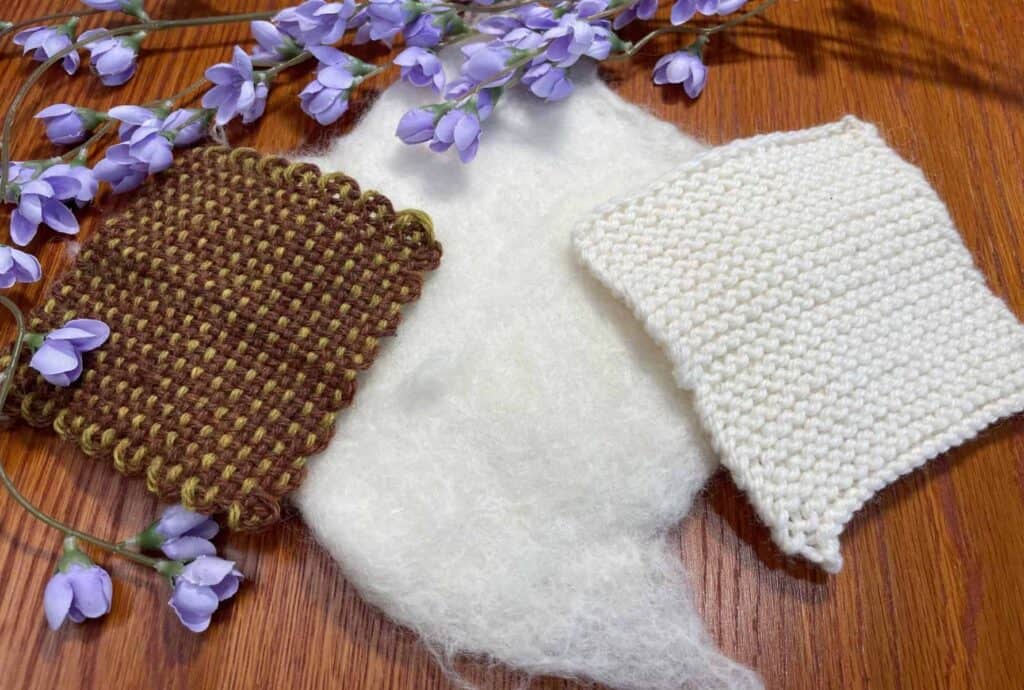- Complete Guide to (57) Almost All Types of Fiber Arts with Photos
- What is Sheep’s wool used for? 53 Great Possibilities
- Yay! the 1 Best Answer to – define the term, fiber. name the four techniques of art that use fiber.
- What is considered fiber art? Expert Answer 5 Little-known Factors
- Mastering Art: How To Make Fabric From Fiber, A Comprehensive Guide
- The Ultimate Encyclopedia of Animal Fiber: Everything You Need to Know
Introduction
It’s ironic. With the free time we have thanks to industrialization, more people are discovering the meditative joy of making the crafts cave people needed to survive. When that comes to fiber art people want to get started. One of the best ways to do that is to learn how to make fabric from fiber. In other words, make basic cloth.
In this article, we will go over the steps of how to make fabric from fiber. Woven, felted, or knitted, you can get started making cloth that you can use. Over time, I will expand on this article with additional details, like deep dives into different breeds of wool, and they will get articles of their own.
You can learn to make a bit of fabric. You can understand the different fibers and basic techniques for cloth construction. Not only will it help you in your journey to explore making fabric from fiber, but it will give you a new appreciation of the fabric all around you.
By the end, not only will you be able to make a rudimentary cloth, but you will also see what a marvel we have created when we built machines to do these jobs for us.
Note: Did you know that in the UK, fiber is spelled fibre? This is a true thing, and since a number of readers come from the UK I will use both spellings.
Fiber Selection
It amazes me just how resourceful our ancestors were. While we can’t pinpoint when ancient people started making fabric, there is evidence of fiber work going back at least 34,000 years. Ancient textiles were made of flax or other bast fibers. These are all plant-based.
As natural fibers only come in two flavors, that brings us to our first consideration, plant fiber or animal fibre? There are pros and cons to each.
First, we will consider plants as a raw material. While ancient bast fibers were often crafted from trees, modern plant fibers come largely from reeds and shrubs.
For the purpose of this article, I’m going to stick with plant fibers that can be used relatively easily from their natural state today, abaca, coir, cotton, flax, hemp, jute, ramie, and sisal.
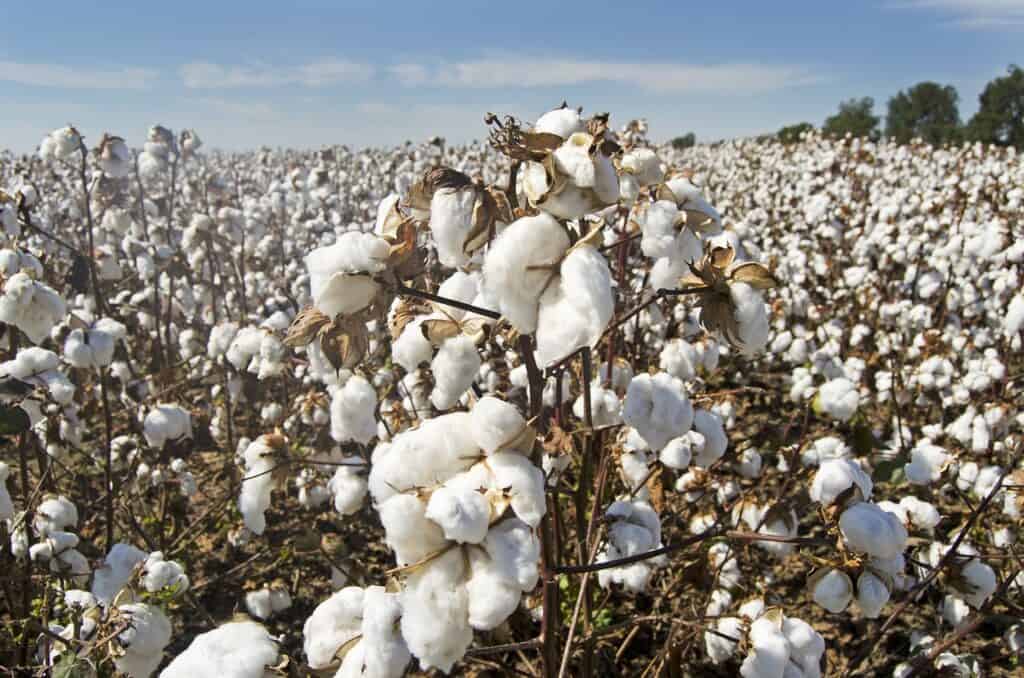
There are other plants that can be used for their natural fibre like milkweed and kudzu, and even more plants that can serve as a basis for making viscose or rayon, but those are special cases. I’ll get to them in future posts.
- Abaca – This species of banana is harvested for its fiber. Abaca is strong and it takes dye well. It does have lignin which is a more woody fiber and can make resulting fabrics coarse. Native to the Philippines, raw fiber can be difficult to come by in other parts of the world.
- Coir – Made from the husks of coconuts. Coir fibers are quite coarse and used for rugs, fishnets, and upholstery. It is resistant to saltwater and also works well for rope
- Cotton – This well-known cash crop has been at the center of wars and international trade for centuries. Called King Cotton in the past, today it is the foundational fiber of the fashion and home furnishing industries. It dyes well and is soft and cool. Cotton is non-elastic and can be very strong when tightly twisted. It is frequently sold as a warp yarn. Cotton fabric is also a staple in warm climates. The cotton plant is also a challenging crop to grow, requiring plentiful water, considerable pesticides, and herbicides.
- Flax – The fiber of the ancient Egyptians, flax makes linen. It has one of the longest histories of usage by humans. The fiber is strong and the seeds are edible. Flax can be grown in poor soil and many different climates. The resulting fabric is cool, washable, and doesn’t pill or conduct static. It can also withstand high temperatures. This is good because linen also wrinkles, lacks elasticity, and can be vulnerable to abrasion especially when dry.
- Hemp – Made from the fibrous portion of the cannabis plant, hemp is a versatile fiber. Fabrics made from pure hemp are very similar to linen, but hemp also does well as a blending fiber adding its strength to softer cottons. It is also antimicrobial, hypoallergenic, and very durable. Hemp grows very quickly with low to average water and does not require pesticides or fertilizers. It is also difficult to dye and the resulting fabric tends to wrinkle.
- Jute – Before plastics, jute fibre sacks dominated the trade markets as containers for grain, sand, and other materials. Like other plant fibers, it is antistatic. However, jute becomes more fragile when wet, holds wrinkles, and makes for a coarse fabric.
- Ramie – Also known as China grass, ramie is in the nettle family and can be harvested up to six times a year. Ramie fabrics hold their shape well and are less prone to shrinkage. Ramie can be bleached and has a natural stain resistance. It is not as easy to dye as some other plant fibers. Ramie can also be brittle and requires a degumming process which adds a lot to the expense of this fiber.
- Sisal – Sisal comes from plants that are part of the agave family. It has good resistance to seawater and is very strong. It also has a low elasticity and makes a very coarse cloth. Today it is most often used to make rugs.
On the whole plant fibers wrinkle, are made of cellulose, lack elasticity, and can be quite flammable. Those are some of the reasons that different fibers are suited to different jobs. This is also why our ancestors made use of animal fibers in addition to plants.
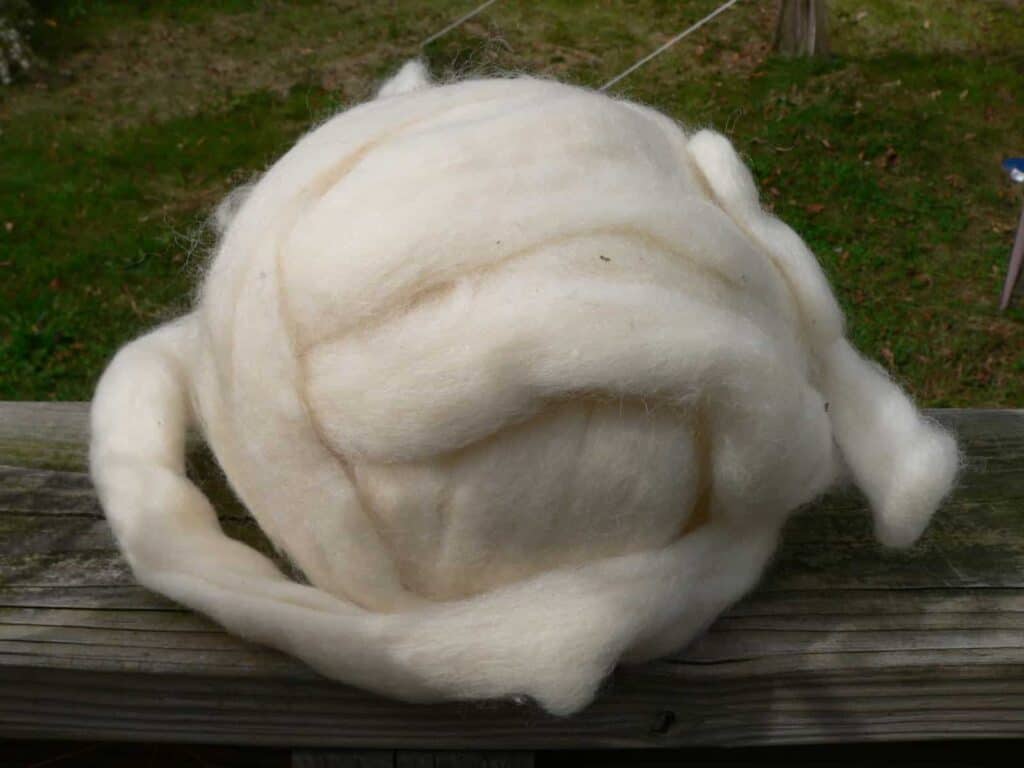
Once humans took up farming, the domestication of animals quickly followed. While evidence suggests most animals were not domesticated for their fiber, our ancestors were quick to recognize the wonderful qualities of animal hair. We will now briefly look at these animal fibers and their properties: alpaca, angora, camel, cashmere, mohair, silk, and wool.
- Alpaca – Alpaca is a soft luxurious fiber. It has no lanolin, so it is suitable for people who have lanolin allergies. Alpaca are easy to keep even on relatively poor pastures and their feet are soft which allows them to graze without damaging the surrounding soil. Their fiber can also be expensive and difficult to find. While it does felt, alpaca fiber lacks crimp which makes it more challenging to spin and less elastic overall.
- Angora – As a fiber, angora has exceptional heat retention properties. It is also extremely soft, wicks moisture, and is anti-static. Angora is also very expensive, requires hand washing even when properly spun and worked, and creates a fuzzy halo regardless of how it is prepared. While it is necessary to shear Angora rabbits to prevent overheating, some producers are unethical in how they go about that. So buy Angora locally or raise your own rabbits. They’re cute!
- Camel – Camel down is an extremely soft feltable animal fiber. Camel is a double-coated breed and requires de-hairing. The strong guard hairs can be used for rugs or blankets. Naturally, in shades of brown, camel down can be dyed, though the colors will be muted darker tones. Exotic in the west, camel fiber can be very expensive and difficult to find.
- Cashmere – King Cashmere is a luxury fiber. Specifically, it is the soft down fibers of goats, and it must be de-haired. It is very soft, heat-retentive, and has a short staple. Cashmere does felt. It is quite light for the warmth it provides. It is also expensive, requires hand washing, and must be spun very thin with a high twist to provide durability.
- Mohair – Mohair is a light, lustrous, semi-elastic fiber with no crimp. While mohair has a high tensile strength, it is also more prone to damage when processed. It is also quick to lose its luster when exposed to acid which presents problems when dyeing. Mohair tends to create a halo in the final fabric form. This can be enhanced with brushing.
- Silk – Silk comes from the cocoons of the silk moth. It is a terrifically light and strong fiber that also takes dye well. Depending on how it is prepared, it can have have strong sheen and luster or a matte finish. Silk also tends to resist wrinkling. A luxury fiber, silk is also expensive. It is also very flammable and vulnerable to wear, sun, and water damage.
- Wool – Wool is the bread and butter of animal fibers. By current count, there are over 200 breeds of wool sheep worldwide, each with different characteristics in their fiber. Most wool has crimp, it is great at regulating temperature and is naturally fire resistant. Wool also takes dye very well. Wool can also be expensive, stain easily, and felt or shrink when washed improperly.
When choosing your fiber, the most important thing to consider is the ultimate purpose of the cloth you want to make. Whether you use a plant or animal fiber will depend largely on the qualities you need for the end result to be functional in its intended purpose.
For many, there are also ethical dilemmas in choosing fibers. These questions are largely outside the scope of this article. There is no absolute perfect answer as much as we might wish there was. Let the pros and cons of each guide you in your choices, and trust that we are all doing our best with what we have available.
Generally speaking, plant fibers work well for breathable summer clothing and for tasks where drape is an important element. Some plant fibers are also very robust and excel in situations where durability is a critical factor.
Animal fibers on the other hand generally provide more warmth and dyeability. They are often feltable which allows them to block wind making them excellent for things like yurts, overcoats, hats, and shoes just for a start. Elastic animal fibers also allow for more knitted applications than the average plant fiber as they are less likely to sag as the knitting ages.
If you are wondering why I didn’t mention polyester fiber or other synthetic fibers, that is because I’m using this article to focus on the fibers that people have been using for thousands of years. Cellulose fiber may be relatively easily converted to viscose today, but you wouldn’t just happen upon it while walking in the woods.
Man made fiber does have its uses in the textile industry and our everyday life. So I’ll save commenting about nylon fibers, synthetic fabric, acrylic fiber, and all things synthetic for a future article.
Preparing the Fiber
Whichever fiber you’ve chosen, it will have to be prepared before it can be spun or felted. Before we go into why you’d choose spinning over felting or vice versa, we will discuss the steps needed to prepare fibers.
Animal fibers are pretty straightforward when it comes to fiber preparation and can be ready to work with just these three processing steps.
1) Wash
2) Dry
3) Card or comb
Some animal fibers may require more effort in these steps, like lanolin heavy wool may take more effort to wash, and very dirty wool may need to be picked of vegetable matter before being carded. While not complicated, these steps need to be done well, especially if you intend to spin the fibers.
Animal fibers that require additional processing are as follows. Silk needs to be degummed to be usable, and it needs to be cut. Silk is formed in one very long strand in the creation of the cocoons. So to spin it to its best potential, it is cut into 4” to 5” segments.
Animals that are double coated, like camels and cashmere may also need to be dehaired. This usually happens as the animal fibre is collected, but not always.
Plant fibers on the other hand can vary more widely in what sort of preparation is needed for them to be usable. Many require some form of retting, where the fibers are soaked in water and allowed to partially decompose. This process removes bonding fibers, allowing the remainder to be more workable.
Other plant fibers may need to be separated from seeds, as with cotton. Ramie is an example of a plant fiber that needs degumming before it can be spun. Once the fibers are clean and workable they often benefit from being carded or bowed.
Proper fiber preparation can make or break the final product, so it is important to put in the effort to make sure these treatments are performed as well as possible.
Spinning techniques
Spinning has been with humanity for quite a long time. Spun flax and bast fibers as old as 34,000 years have been found around the world. Spinning puts a twist in fibers which makes otherwise weak and short segments into long strings that can be put to more use.
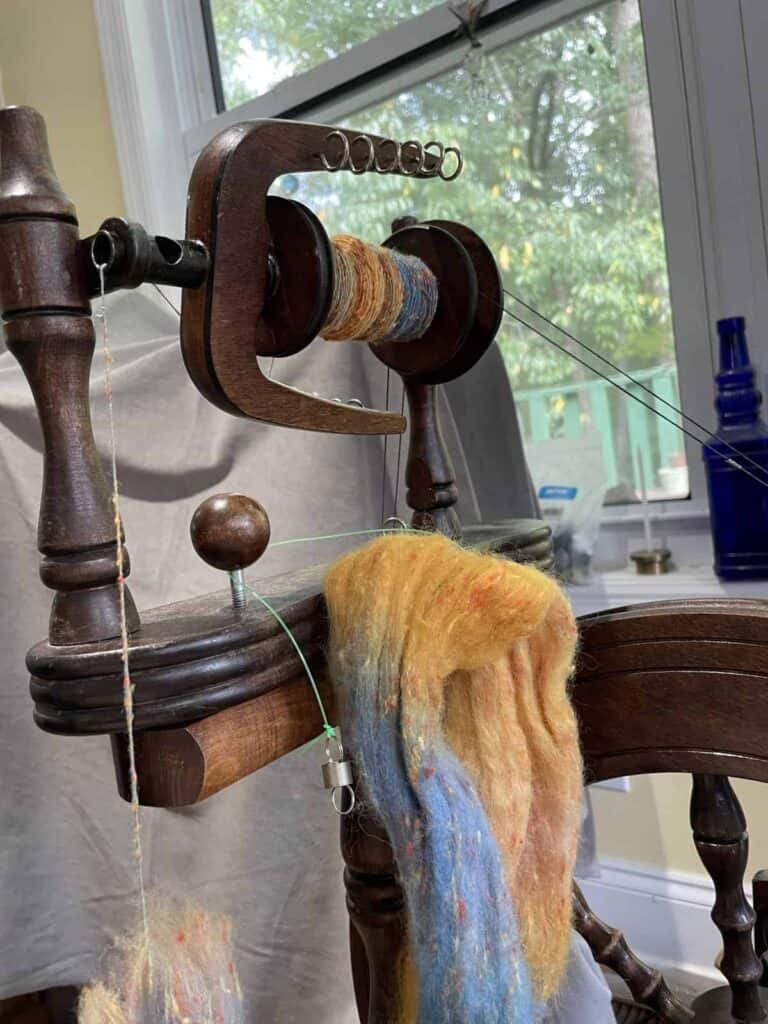
Spun fibers can be plied together to balance the twist and make a final yarn or string that is significantly stronger. The ability to make long continuous strings was essential to make weaving fabric possible. The warp strings hold all of the tension when fabric is woven.
The warp of any woven fabric is stretched through a loom and becomes the foundation of the future cloth. The weft is spooled on a shuttle and passed back and forth through the warp strings. As this process is repeated, the weft gradually builds up, creating something most would call a cloth.
When the final fabric is finished, the strings of the warp maintain the overall structure of the fabric.
Because the weft is not worked under the same high tension as the warp, other fibers and varied twist amounts are optional. That said, a spun weft, while not necessary, is much more durable to wear and tear.
This would have been incredibly important to our ancient ancestors. Fiber prep and spinning take a huge amount of time. It would be important for the resulting fabric to last as long as possible. Even today, it’s wise to consider the final use of a string when deciding how much twist to apply when spinning.
As the techniques of knitting, crochet, netting, and knotting were developed, spun strings were able to produce different types of cloth. Knitting in particular was able to create an elastic fabric that had very different qualities than woven cloth.
A skilled spinner would tailor the amount of twist to the final use of the resulting fabric. For example, these would be the steps one might follow to spin a warp string.
- Choose your fiber. A warp yarn must be very strong under tension and it must not stretch. With those requirements, cotton is often the best choice.
- Spin the cotton with a high twist. If I were working back in the day I’d use a walking wheel. These were developed for spinning cotton. They can add a significant amount of twist. This is necessary because cotton has a very short staple length.
- Spin an additional ply or two and then spin all the plies into a single string.
- Finish the final yarn by spooling it off onto a niddy-noddy, measuring the yardage and securely tying the skein with four figure eight ties.
- Set the twist by washing or steaming the final yarn. Cotton and other plant fibers sometimes benefit from heating the wash bath to a low simmer. This would also be a great opportunity to dye the final yarn.
- Rinse and then gently squeeze out the remaining water and hang to dry.
If I were spinning fiber for a knitted sweater, I would follow these steps.
- Choose your fiber. A knitted garment is elastic and will be warmer and more resilient if made with sheep wool which has a lot of crimp. If it is close to sensitive skin, softness is also important. With those requirements, a merino, cormo, corridale, or other soft wool is the best choice.
- Spin the wool with an average twist. A sweater takes a lot of yarn, so I would spin that quantity on a spinning wheel. You can also use a drop spindle but that will take a lot more time.
- Spin at least two additional plies. The more plies, the rounder the final yarn. Two-ply yarn is great for lace, but more rounded multi-ply yarns make for a more robust knitted cloth.
- Finish the final yarn by spooling it off onto a niddy-noddy, measuring the yardage and securely tying the skein with four figure eight ties.
- Set the twist by washing the final yarn. If you want to dye the yarn at this time, go ahead and heat the wash bath. Animal fibers are more fragile when wet, and many are prone to felting so it is important to avoid agitation.
- Rinse if necessary and gently press out extra water with the skein wrapped in a towel.
Crafting Your Cloth
Cloth can be crafted from fiber in several different ways, weaving, single-string chains, and felting. Weaving includes techniques such as sprang, and is done on a frame or loom.
Single-string chains are any techniques that involve using a single strand of yarn that is worked to form a chain of stitches. Knitting, crochet, nalbinding, and other forms of knotting all fall into this category.
Felting is also a way to make cloth. This involves using loose feltable animal fibers and agitating them in hot soapy water until they bind together in a solid sheet.
Now we will go over the steps to make a very basic cloth using a method in each of the three categories.
Weaving Cloth
To weave a basic small piece of cloth, you will need a loom or frame. I will write instructions for a pin loom because it is the smallest loom that I am aware of, but you can also use it to make advanced woven patterns.
It’s also possible to stitch the small cloth pieces together to make full garments. Until large advanced looms were developed, our ancestors would have been working with smaller pieces of cloth as well.
Notes on weaving. The size of the cloth you can make is limited by the type and size of the loom you are using. Within that limitation, there are many different patterns that you can work with your weaving.
While there is considerable skill involved in making advanced patterns and working on large looms, it’s relatively easy for a beginner to make a workable piece of cloth on a simple loom or frame right from the beginning.
Because weaving must be worked on a frame or loom, it’s not very portable. Weaving produces a flat fabric with little stretch. The resulting cloth is flat. It can be worked into a garment, but this requires the additional step of sewing.
This video demonstrates how to use a pin loom to make a square of basic woven cloth.
To make a basic woven cloth on a pin loom, proceed as follows:
- Using a long piece of yarn, load the warp starting from the left-hand corner and lay the yarn up and down over the pins. The very first row begins directly beside the left side pins and wraps around the two pins at the top.
- Bring the yarn back down and place it in the middle of the four pins on the bottom left corner.
- Wrap the last two pins and then bring the yarn back to the top of the loom.
- At the first group of three pins on the top left of the loom, wrap the last two pins and bring the yarn back to the bottom, wrapping the last two pins in the group of three at the bottom.
- Repeat this across the loom until you get to the four pins at the top right corner of the loom.
- Wrap the middle two pins of the four and bring the yarn down to the bottom right corner.
- Lay the yarn between the two pins at the bottom right.
- Rotate the loom one-quarter turn to the right.
You are now working a weft row. Refer to the video if you are having trouble seeing which pins to wrap. Work the weft as follows:
- Wrap the weft yarn around the two pins at the bottom left of the loom.
- Bring the yarn back to the top of the loom and three pins at the top left corner of the loom.
- Wrap the last two pins in the grouping of three and bring the weft yarn down to the first set of three pins at the bottom of the loom.
- Wrap the last two pins in the group of three.
- Repeat this across the loom until you get to the two pins at the top right corner.
- Lay the yarn between the last two pins.
- Rotate the loom one-quarter turn back to the left.
You are now working on the second warp row. Refer to the video if you are having trouble seeing which pins to wrap. Work the warp as follows:
- At the top left corner, place the warp yarn between the two pins.
- Bring the yarn down to four pins at the bottom right corner.
- Wrap the two pins in the middle of the group of four and bring the yarn back to the top.
- Wrap the first two pins in the group of three at the top of the loom. You should notice that this warp is offset from the first layer of warp.
- Bring the yarn back down to the bottom of the loom.
- Wrap the first two pins in the set of three at the bottom of the loom.
- Repeat wrapping the first two pins at the top and then the bottom, until you get to the four pins at the top right corner of the loom.
- Wrap the first two pins and bring the yarn down to the bottom right corner.
Working carefully to avoid losing the work already on the loom, wrap the loose end of the yarn 5 times around the outside of the pins. This will give you the right amount of yarn necessary to finish the last weft layer and finish your piece of cloth. After you have your 5 wraps, cut the yarn and thread it into your long needle. Do not rotate the loom.
- Starting in the bottom right corner of the loom, thread the needle over the yarn wrapped on the bottom two pins by placing the needle between the two pins and immediately placing the needle under the very next strand of the warp.
- Without pulling the needle out lift the tip so that it goes over the very next strand.
- Now work across going over and under each strand until you get the tip of the needle to the bottom left corner.
- Bring the tip of the needle under the last warp strand, and push it out below the three pins in the bottom left-hand corner.
- Now pull the needle through.
- Draw the weft yarn through the fabric until all excess has been moved to the left-hand side and the remaining yarn is all snugly woven. Avoid pulling the yarn tight. That makes for a distorted and uneven fabric.
- Now look at the three pins on the left bottom corner of the loom. Place the tip of the needle between the top two pins in that grouping of three, going over the yarn that wraps around the pins and under the very next warp strand just to the right of the pins.
- Work the tip of the needle across the loom going over then under each remaining warp strand.
- Repeat steps 5 through 8 until you reach the top left corner row.
- At the top left corner, place the needle above the two pins on the top left corner.
- Put the tip of the needle over the yarn that forms a loop around the corner pins of the top and side of the left top corner of the loom.
- Move the tip of the needle under the next warp strand just to the right of the pins and work over and under each warp strand across the top of the loom. Work carefully so you don’t miss a strand on this row. When complete this row will hold the integrity of the rest of the fabric.
- Pull the needle and any remaining yarn after working the last warp strand.
- Slide the square of cloth off the pins and weave in the loose ends.
- Enjoy your new piece of plain weave fabric.
Knitting Cloth
Knitting is another way to make cloth using just yarn and needles. Knitting works by forming a series of interconnected loops by pulling the yarn through completed loops to extend the chain row by row.
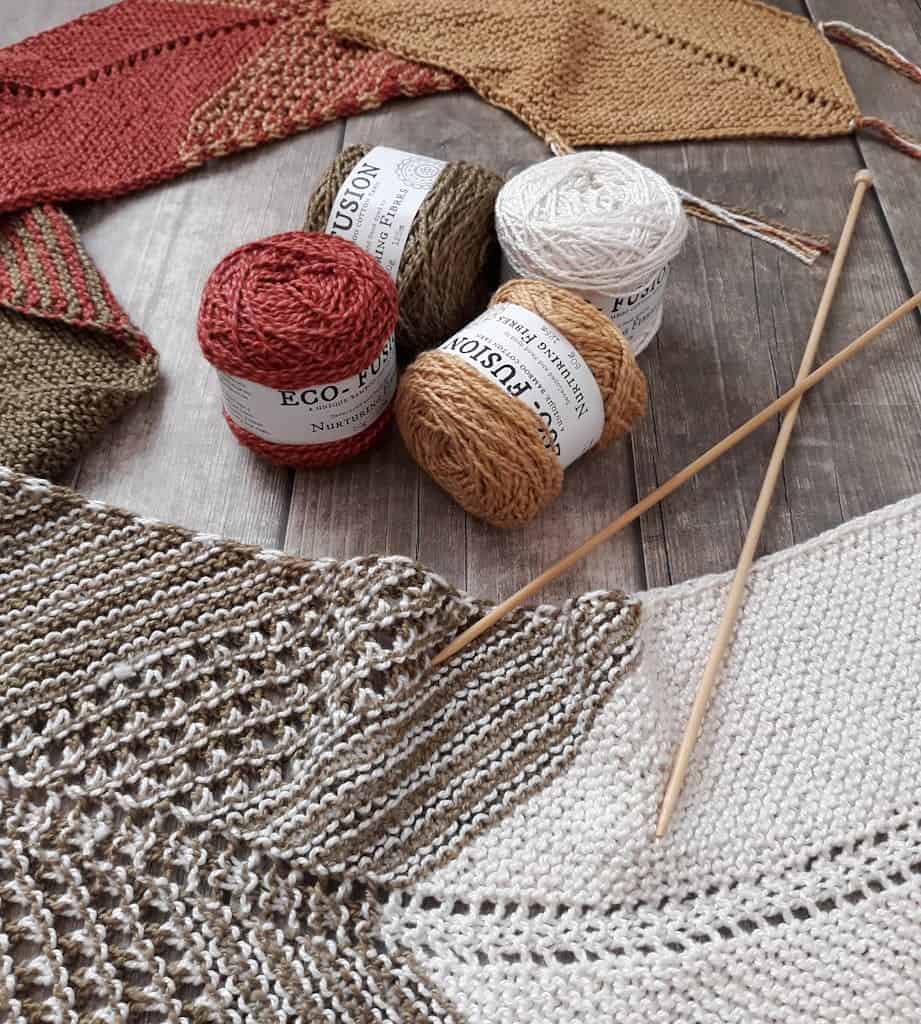
Knitting produces a stretchy fabric. It can be worked 3 dimensionally so that there are no wasted stitches in any fitted construction. Knitting is also very portable. You can also work the stitching to have a variety of patterns, cables, lace, multiple colors, and more.
Knitting takes practice. Most people have to persist at knitting for about two weeks to get the hang of it. To have a consistent tension or produce advanced patterns or colorwork can only be done by building skill over time.
Knitting is worked one stitch at a time. This often means it takes longer to arrive at a complete piece of fabric than either weaving or felting.
To make a knitted piece of cloth, you are going to need a pair of knitting needles. I recommend US size 7 if this is your first try at knitting. You will also need yarn. I recommend DK-weight yarn.
With knitting, it is important to pair needle size and yarn weight to ensure that the knitting flows easily and you produce a piece of cloth that is dense enough to be protective, but not so tightly worked that it lacks flexibility.
Knitting is a skill that requires practice. If you are new to knitting, you may find that holding the needles and yarn feels very awkward. This is normal. Think of learning to knit like learning to ride a bicycle.
If you practice every day for about two weeks, that should give you enough time for your muscles to learn the process and you don’t have to think about each step very much.
It may take a bit longer to develop a consistent tension, but most of the hurdles can be cleared quickly if you practice consistently. If you find you’re having difficulty, check in with a local knitting group or take a class at a fiber store or festival.
To make a basic knitted cloth, follow the following steps:
- Using your yarn, create a slip knot. Place the slip knot on your needle.
- With the other needle, insert the tip into the slip knot stitch. Wrap the loose yarn which is connected to the yarn ball around your needle.
- Now pull this stitch back through and place it on the needle next to the slip knot stitch.
- Now insert the tip of the needle into the new stitch you just made. Wrap the yarn attached to the yarn ball around your needle.
- Pull this stitch back through and place it on the needle next to the stitch you worked it on.
- Repeat steps 4 and 5 until you have the desired number of stitches.
- Now place the tip of the needle through the last stitched you created.
- Wrap the yarn attached to the yarn ball around your needle. This is a knit stitch.
- Pull this stitch through, leaving it on the second needle.
- Now work the remaining stitches in the same way one at a time until all stitches have been worked and transferred to the second needle.
- Now switch the needles in your hands so that the needle with all the stitches is in your off hand and the empty needle is in your dominate hand.
- Whether you are knitting left or right-handed, repeat steps 7 through 11 until your cloth is the desired length. Then bind off.
- To bind off put the tip of your needle into the last stitch worked. Work as you would to create a knit stitch. (Steps 7 through 9)
- Work the next stitch as a knit stitch.
- With two stitches on the needle, lift the first stitch worked over the second stitch, finishing with one stitch on the needle.
- Knit the next stitch.
- Again with two stitches on the needle Lift the prior stitch over the new stitch.
- Repeat steps 16 and 17 until all the stitches have been worked.
- Cut the yarn and thread the tail through the last stitch and pull tight.
- Weave in the loose yarn at either end of the finished knit fabric.
If you’d like to explore the horizons of knitting, check out my premium knitting patterns.
Felting Cloth
Felting cloth may be the easiest way to produce a workable fabric. Feltable wool will naturally mat when washed with soap and agitated. With the development of felting needle technology, today almost any fiber can be felted.
For our purposes we are going to focus on traditional wet felting. Wet felting can be made with minimal tools. All that is required is feltable animal hair, hot water, soap and agitation.
If you have ever put a wool sweater in the wash by accident and it came out two sizes smaller, you have felted.
Before you begin, you will need feltable wool, soap, and hot water. A felting tool can be helpful, but if you don’t have one many kitchen tools or household items can become improvised felters. Possible items include spoons, spatulas, ice trays, bubble wrap, and potato mashers. You can also wear rubber gloves and felt by hand.
You will also want to work in a sink, basin, or Rubbermaid tub. Anything that can safely hold water can work as a place to felt.
Follow the following steps to make a wet felted fabric:
- Inspect you wool fiber and make sure that it is well prepared for felting, and comes from a sheep with feltable wool.
- If needed, comb, card, or pick the fiber to loosen the lock structure for easier felting.
- Take a portion of the prepared fiber and arrange it in a square at least a third larger than you want for the finished cloth. While you do this, make sure the fibers are going in roughly the same direction.
- Take more fiber and place it on top of the first amount. Arrange these fibers so that they are perpendicular to the first layer.
- Make several more layers arranging the fibers or each layer perpendicular to the one below.
- Use as many layers as needed to achieve the desired fabric weight for your finished project. If you don’t have a finished project in mind, do a minimum of six total layers to ensure an even fabric without weak spots.
- Before you begin to felt, inspect the fiber layers for uniformity. If you find spots that are don’t have enough coverage add more wool.
- You are now ready to felt. Put your soap in a sink, basin, or tub, and add hot water.
- Now gently add your layered wool.
- Using a tool, or a gloved hand if you don’t have a tool, gently agitate the wool.
- Continue agitating the wool gently until the fibers begin to matt together.
- When the fibers are felted enough to hold the intended shape, you can increase how aggressively you agitate. More vigorous agitating will make for a more tightly felted and stronger fabric.
- Continue agitating until the wool has felted into a firm fabric and has shrunk.
- You can adjust the size of your finished cloth by agitating until it shrinks the desired amount.
Finishing Touches
Now that you have some basic cloth, you can do some finishing touches that will clean up its appearance, and make it more usable. Woven and knitted cloth will have loose ends.
In knitted material, weave the loose ends back into the work by following the stitch pattern and making the tail yarn blend in the work as invisibly as possible.
With a woven cloth, you may need to tie the loose ends with weaver’s knots or some other decorative finish. If you used a pin loom, then weave in those tail yarn as invisibly as possible.
With the felted cloth you can leave it as is when finished, or cut the edge of the finished cloth to make it even and in a uniform shape. It really depends on what purpose you have for it.
Next Steps
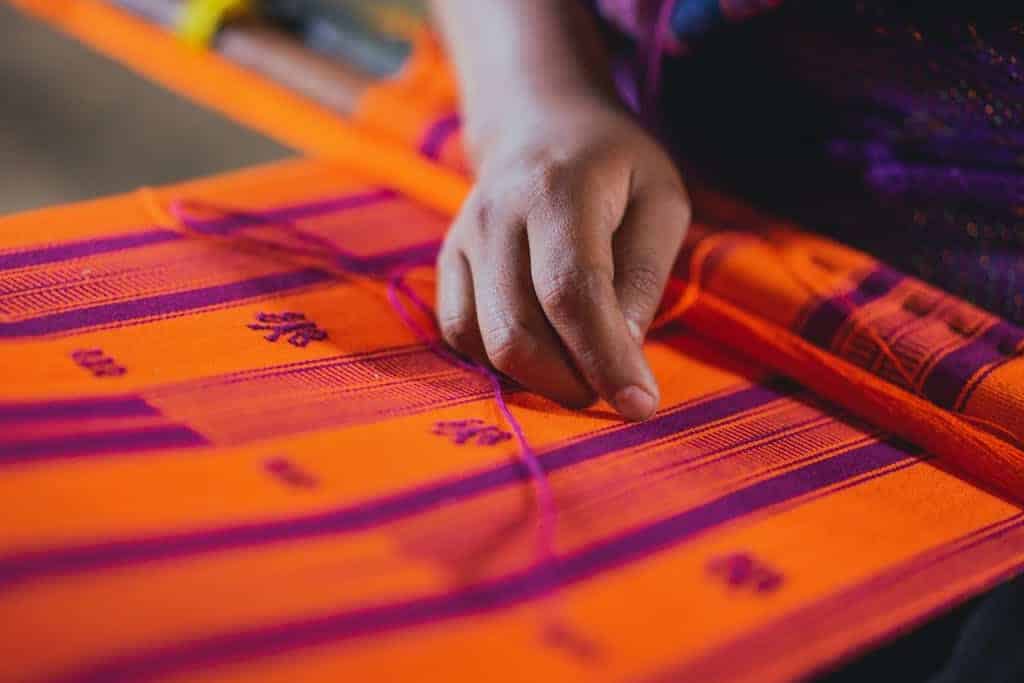
Now that you have made fabric from fiber, you can put it to use. Any finished cloth can become a household tool like a trivet, coaster or pot holder. They can be dyed, embellished, and turned into an art piece, or pin cushion.
If you found the process gratifying, you may want to make more or get the tools to make bigger pieces of cloth.
String and stick work or felting can both be adapted to make the exact shape, or near exact shape you’d want to construct a garment or piece of home decor without needing many further tools.
So you can make knit, crochet, or felted garment and homegoods with little more than additional practice.
Weaving is limited by the size of your loom. But you can sew finished woven fabrics together to make a larger material. To construct a shaped item like a garment you’ll have to learn some sewing skills. This can all be very gratifying.
With these basic skills, a few tools and practice the world is now your fiber oyster.
Would you like to see more of my writing? Try a story snack or a poem. Both are low calorie and good for the heart. Coming to the Eastern TN area? Check out my directory of fiber art attractions.
Like this writing and want to see more? Your donation will help me maintain and expand this site.
References
Barber, E.J.W. (1992). Prehistoric textiles: The development of cloth in the Neolithic and bronze ages with special reference to the Aegean. Princeton University Press.
Harvardgazette. (2009, September 10). Oldest-known fibers to be used by humans discovered. Harvard Gazette. https://news.harvard.edu/gazette/story/2009/09/oldest-known-fibers-discovered/
Robson, D., & Ekarius, C. (2011). The Fleece & Fiber Sourcebook: More than 200 fibers from animal to spun yarn. Storey Pub.

